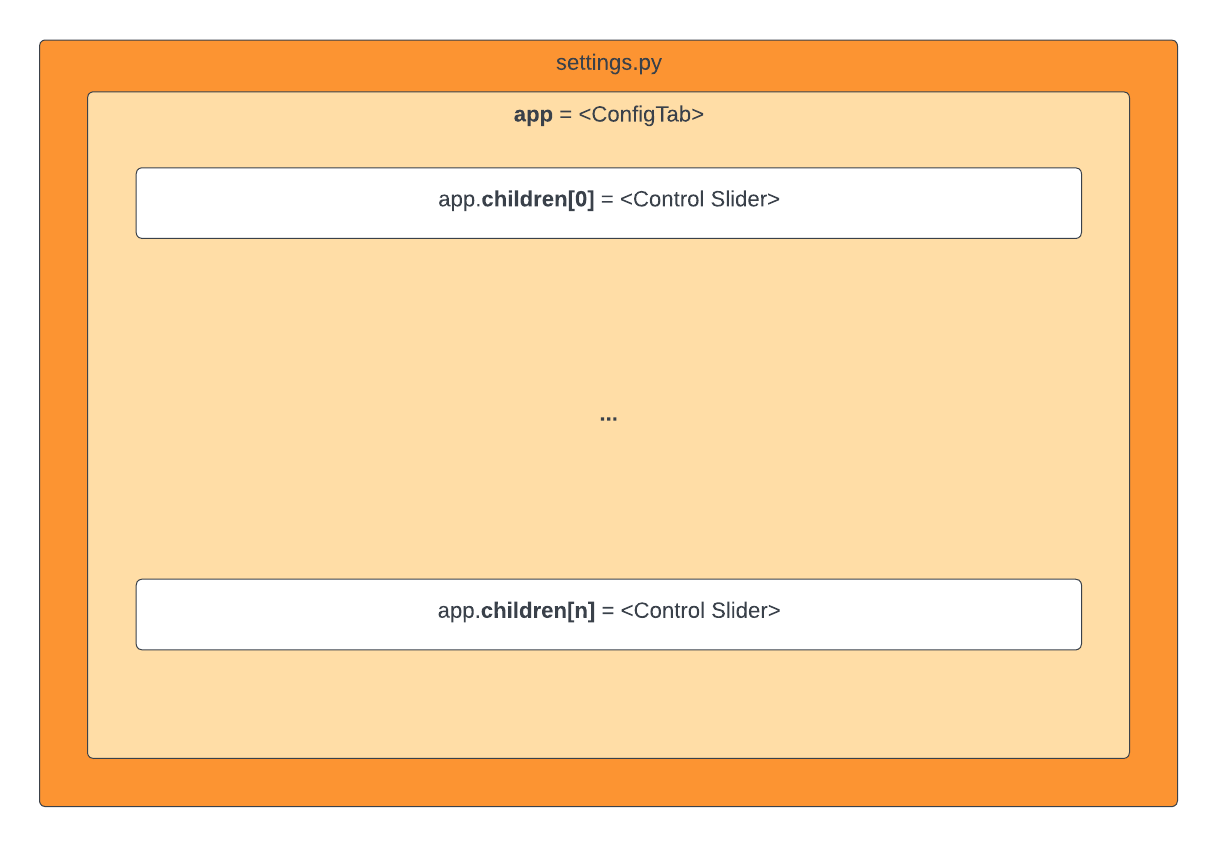webapp.settings¶
Widget definition module: Defines UI elements used for adjusting system settings, namely PID tuning parameters and the ‘tick’ interval of the microcontroller.
Use the following code to import and display the widgets defined in this module:
- example:
>>> from webapp import settings
>>> display(settings.app)
Widget layout¶

Widget objects¶
- webapp.settings.app = ConfigTab(config=appState.config)¶
Module top-level container widget - holds all the widgets defined in the
webapp.settingsmodule, which make up the Settings tab in the dashboard app.Allows the Settings tab to be imported into the dashboard app using the code below:
- Example:
>>> from webapp import settings >>> settings.app
Helper classes¶
- class webapp.settings.ConfigTab(**kwargs: Any)¶
Customised subclass of
ipywidgets.widgets.Accordionclass, styled to provide a drawer (or ‘accordion’)-like interface, with multiple sliders for adjusting system parameters.The
ConfigTabobject contains a number ofControlSliderobjects, which each control a system parameter that can be adjusted, such as PID tuning parameters.
- class webapp.settings.ControlSlider(**kwargs: Any)¶
Customised subclass of
ipywidgets.widgets.FloatSlider`widget, modified so that it automatically takes a dictionary containing items it can modify (:param:`config`) and a target ‘key’ from the dictionary, specifying the specific item it should modify (:param:`target`).
Code listing¶
"""
Widget definition module: Defines UI elements used for adjusting system
settings, namely PID tuning parameters and the 'tick' interval of the
microcontroller.
Use the following code to import and display the widgets defined in this module:
:example:
>>> from webapp import settings
>>> display(settings.app)
"""
from ipywidgets.widgets import Accordion, FloatSlider, Layout
from IPython.core.display import display, HTML # IPython Notebook functions
from importlib import reload
from webapp.shared import appState
class ConfigTab(Accordion):
"""
Customised subclass of :external:class:`ipywidgets.widgets.Accordion`
class, styled to provide a drawer (or 'accordion')-like interface,
with multiple sliders for adjusting system parameters.
The :class:`ConfigTab` object contains a number of :class:`ControlSlider`
objects, which each control a system parameter that can be adjusted,
such as PID tuning parameters.
"""
def __init__(self, config= appState.config, **kwargs):
"""Initialse new ``ConfigTab`` object
:param config: A dictionary of configuration parameters, defaults to
``appState.config``
:type config: _type_, optional
:return: ``ConfigTab`` object
:rtype: ``webapp.settings.ConfigTab``
"""
self.config = config
super().__init__(
children=
[
ControlSlider(self.config, 'KP'),
ControlSlider(self.config, 'KD'),
ControlSlider(self.config, 'KI'),
ControlSlider(self.config, 'INTERVAL')
],
#layout=Layout(width='240px'),
**kwargs
)
self.set_title(0, 'Proportional gain')
self.children[0].value=self.config['KP']
self.children[0].min=0
self.children[0].step=0.5
self.children[0].max=100
self.set_title(1, 'Integral gain')
self.children[1].value=self.config['KD']
self.children[1].min=0
self.children[1].step=0.5
self.children[1].max=100
self.set_title(2, 'Derivative gain')
self.children[2].value=self.config['KI']
self.children[2].min=0
self.children[2].step=0.5
self.children[2].max=100
self.set_title(3, 'Time interval')
self.children[3].value=self.config['INTERVAL']
self.children[3].min=0
self.children[3].step=0.05
self.children[3].max=5
def reset(self):
self.__init__()
for child in self.children:
child.config = appState.config
class ControlSlider(FloatSlider):
"""
Customised subclass of :external:class:`ipywidgets.widgets.FloatSlider``
widget, modified so that it automatically takes a dictionary containing
items it can modify (:param:`config`) and a target 'key' from the dictionary,
specifying the specific item it should modify (:param:`target`).
"""
def __init__(self, config, target, **kwargs):
"""
Initialise a new ``ControlSlider`` object, to control the value of
:param:`config`[:param:`target`].
:param config: A dictionary of configuration parameters, defaults to
:attr:`webapp.shared.appState.config`
:type config: ``dict``
:param target: Dictionary key for the parameter in :param:`config` that
the slider will control
:type target: ``str``
:return: :class:`ConfigTab` object
:rtype: :class:`webapp.settings.ConfigTab`
"""
super().__init__(
value=1,
min=0,
max=100,
step=0.05,
disabled=False,
continuous_update=False,
orientation='horizontal',
readout=True,
readout_format='.2f',
layout=Layout(width='62.5%'),
**kwargs
)
self.config = config
self.target = target
self.observe(self.handle_slider_change, names='value')
def handle_slider_change(self, change):
self.config[self.target] = change['new']
# Define a slider widget for the target temperature
# Options are largely self-explanatory
app = ConfigTab(
layout=Layout(margin='0 0 0 0',maxwidth='81.25%',maxheight='83.33%',
padding='0 0 0 0')
)
"""
Module top-level container widget - holds all the widgets defined in the
:mod:`webapp.settings` module, which make up the Settings tab in the
dashboard app.
Allows the Settings tab to be imported into the dashboard app using the code
below:
:example:
>>> from webapp import settings
>>> settings.app
"""